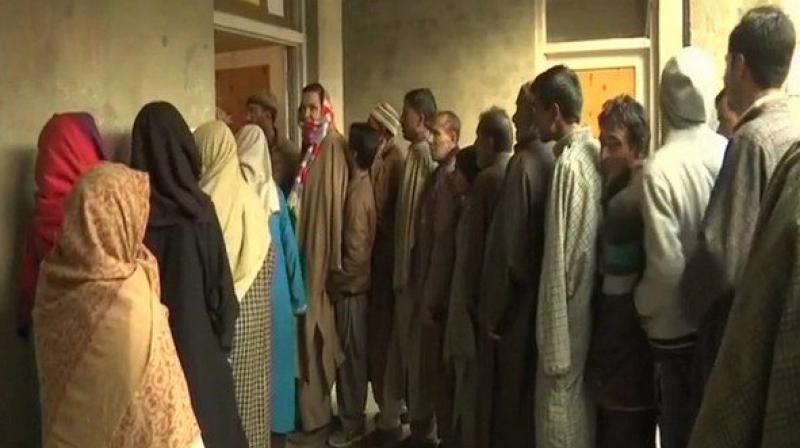Cross-LoC trade facing a slow death
The LoC trade was as popular in Jammu as it was in the Valley, and its popularity cut across political and religious divides.

It is accepted by all that Kashmiris feel a deep sense of alienation and oppression, which they resent intensely. But there is another aspect that is often overlooked: Kashmiris feel that they are literally imprisoned in a cage from which almost all exit routes are barred save one, to India, which is also not without peril. Kashmiris are distrusted and treated poorly in many parts of India, whether as students or as traders.
Now, even one other solitary opening — trade across the Line of Control with Pakistan-occupied Kashmir — is facing a slow death. It has seen many ups and downs in the decade since it was begun. It always operated on barter; banking and telecommunication facilities were always denied.
Initially, it was proposed as a confidence-building measure by Atal Behari Vajpayee. His successor, Manmohan Singh, pursued it in earnest until the LoC trade was set going. Its political impact was considerable.
The LoC trade was as popular in Jammu as it was in the Valley, and its popularity cut across political and religious divides. Despite this, no effort was made to improve the arrangements by providing banking facilities and telecommunications. Matters reached a ludicrous stage a few years ago when Mufti Mohammad Sayeed first became chief minister. In one sector of the Kanchenjunga River, the divide is very narrow. Divided families discovered that they could easily throw boxes of gifts to each other. It flourished only for a short time. The security forces put an end to it. Security was a false excuse. The crowds could well have been managed and the gift boxes properly searched. It was the opening to “the other side” —which was unacceptable. Even this small opening was ended. It is this mentality that inspired the “slow poisoning” of the LoC trade. As a Kashmiri correspondent, Ishfaqul Hassan, reported from Srinagar very recently, “(T)he cross-LoC trade is showing signs of stagnation sending shivers through the traders’ community across J&K. Started in October 2008, the cross-LoC trade was considered as the mother of all confidence-building measures between India and Pakistan.”
One has heard of many protests at New Delhi’s calculated indifference to the LoC trade. Rakesh Gupta, president of the Jammu Chamber of Commerce and Industry, worded his protest with admirable precision. “It is unfortunate that one of the most important confidence-building measures initiated by the then Prime Ministers of India and Pakistan 10 years ago was dying a slow death due to the absence of proper follow-up action.” The effect of its closure on the minds of the people of Kashmir — already feeling suffocated, and forcibly contained and controlled — can well be imagined. This one avenue offered some hope of other and more promising openings. Now, all the doors will be shut in their face.
In no part of the subcontinent does history matter as much as it does in Kashmir.
Equally, no other part has had such roaring exchanges with foreign powers, defying the British rulers, as did the maharaja and people of Kashmir. Emperor Akbar is admired throughout the subcontinent. But Kashmiris hate him for destroying their independence by invading and annexing their land in 1586.
Likewise, Kashmiris can still recall the times, even during the rule of the tyrannical Dogras and their British overlords, when Russian and Central Asian merchants came to the region for its world-famous shawls. Movement of men and materials like pilgrims, books, shawls, gold tillas, Russian textiles, Kokandi silk, Bukharan rumals and coral formed an essential ingredient of the interaction between Central Asia and Kashmir.
The British imposed on the maharaja their resident in Kashmir to detect his dealings with other countries. Trade from British India would flow through Kulu via the Chang Chenmo route to Yarkand, bypassing the maharaja’s customs officials in Leh. This idea was so attractive that, in 1870, a special treaty signed in Sialkot in 1870 by the viceroy Lord Mayo and Maharaja Ranbir Singh, which would elevate this route to the status of a “free highway”, to be dotted with supply depots and rest houses jointly supervised by British and Kashmir officials. It became known as the “treaty route”. Haj pilgrims from Central Asia would pass through Kashmir to board ships at Karachi or Bombay.
To this day, Kashmiris fondly recall that history. In 1970, this writer went for a walk in the interiors of Srinagar with the editor of a prestigious weekly. All of a sudden, he exclaimed, “This is not India. It is Central Asia.” Constitutional oppression apart, Kashmiris must also be freed from physical restraints and allowed to breathe freely. That will facilitate a political solution. Begin with the Jammu-Sialkot road.
By arrangement with Dawn

